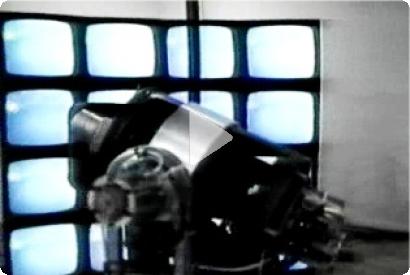Please wait a few moments while we process your request

Woody Vasulka
The Theater of Hybrid Automata, 1990
Woody Vasulka uses the "Lightning", a musical instrument developed by Donald Buchla. In this ongoing project begun in 1985, Woody combines hardware with sophisticated software for processing real-time images. The project aims to develop complex interfaces between the viewer/performer and technologies and to establish ways to exchange information between machines. Epistemological concerns underlie the creation of this work. Here, Woody explores the disappearance of the body in a virtual space. Paradoxically, the installation suggests an intense relationship between synthetic images and the materiality of the devices generating them.
The project to construct an automated theatre began in 1985 when Steina, Woody and the singer Joan La Barbara used an interface to activate, in real time, the audio and video data stored on a computer hard disk (see Voice Windows (1986)). Heartened by these initial experiments, Woody teamed up with David Dunn to build the scenographic elements for a performance by La Barbara called Events from the Elsewhere (1990). Most of the technological components from this piece were later recycled for Theatre of Hybrid Automata.
This hybrid work, which serves as both a theatre set and an installation, has taken different shapes over the years depending on the exhibition space used. Essentially, the work covers a cubic area defined by targets and screens placed along its edges. In its centre, a gyroscope fitted with a video lens is programmed to move on a 360-degree axis in every direction. The device moves according to two modes: pointer mode (the camera heads toward zones predetermined by the computer) and positioning mode (sensors pick up digital coordinates as they randomly scan the space). The sensors route the data to a voice-recognition device, which records and translates the information so that a synthesized voice can announce the direction the gyroscope's lens is pointing toward (north, south, east, west). With help from the MIDI protocol, a computer runs the components of this environment in real time and controls the built-in functions of a laser-disc player. Projectors emit video images of the surrounding space captured by the video head, as well as a 3-D animation that converges with the gyroscope's movements.
The project to construct an automated theatre began in 1985 when Steina, Woody and the singer Joan La Barbara used an interface to activate, in real time, the audio and video data stored on a computer hard disk (see Voice Windows (1986)). Heartened by these initial experiments, Woody teamed up with David Dunn to build the scenographic elements for a performance by La Barbara called Events from the Elsewhere (1990). Most of the technological components from this piece were later recycled for Theatre of Hybrid Automata.
This hybrid work, which serves as both a theatre set and an installation, has taken different shapes over the years depending on the exhibition space used. Essentially, the work covers a cubic area defined by targets and screens placed along its edges. In its centre, a gyroscope fitted with a video lens is programmed to move on a 360-degree axis in every direction. The device moves according to two modes: pointer mode (the camera heads toward zones predetermined by the computer) and positioning mode (sensors pick up digital coordinates as they randomly scan the space). The sensors route the data to a voice-recognition device, which records and translates the information so that a synthesized voice can announce the direction the gyroscope's lens is pointing toward (north, south, east, west). With help from the MIDI protocol, a computer runs the components of this environment in real time and controls the built-in functions of a laser-disc player. Projectors emit video images of the surrounding space captured by the video head, as well as a 3-D animation that converges with the gyroscope's movements.
Vincent Bonin © 2001 FDL
Index:
- Steina and Woody Vasulka Fonds
• Presentation
• Works by Steina and Woody Vasulka
• Works by Woody Vasulka
• Works by Steina - Yvonne Spielmann, Video and Computer
• Introduction
• Image as process
• The Reflexive Medium
• The Reflexive Medium (cont'd)
• The Matrix of Electronic Languages
• Image Becomes Object
• The Art of Intervention
• Conclusion
• Description of works
• Selection of tools
Related page:
 Woody Vasulka, The Brotherhood, 1990-1998
Woody Vasulka, The Brotherhood, 1990-1998After moving to New Mexico, Woody began sifting through the military surplus waste cast off by the nearby Military Research Centre in Los Alamos.




